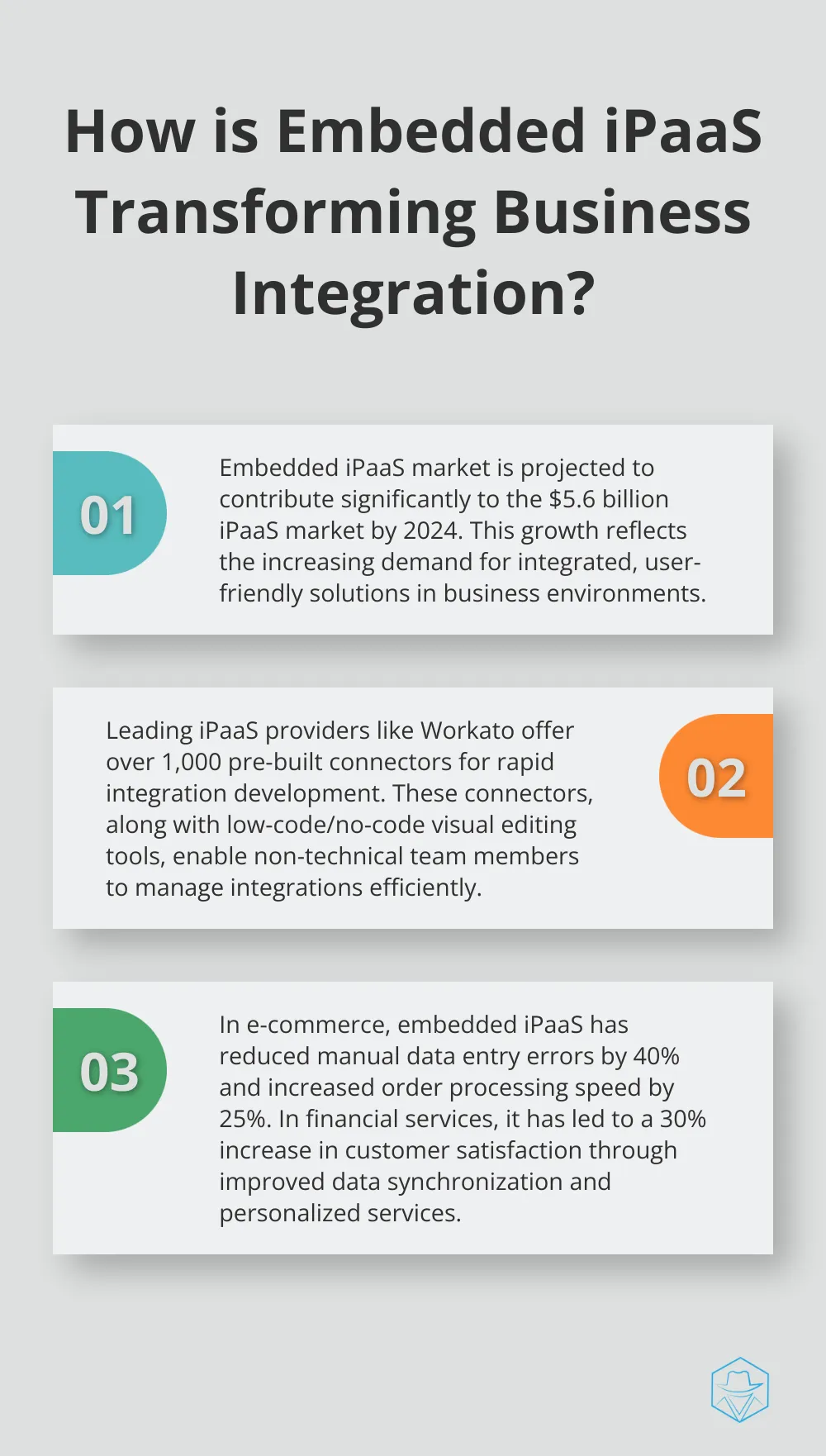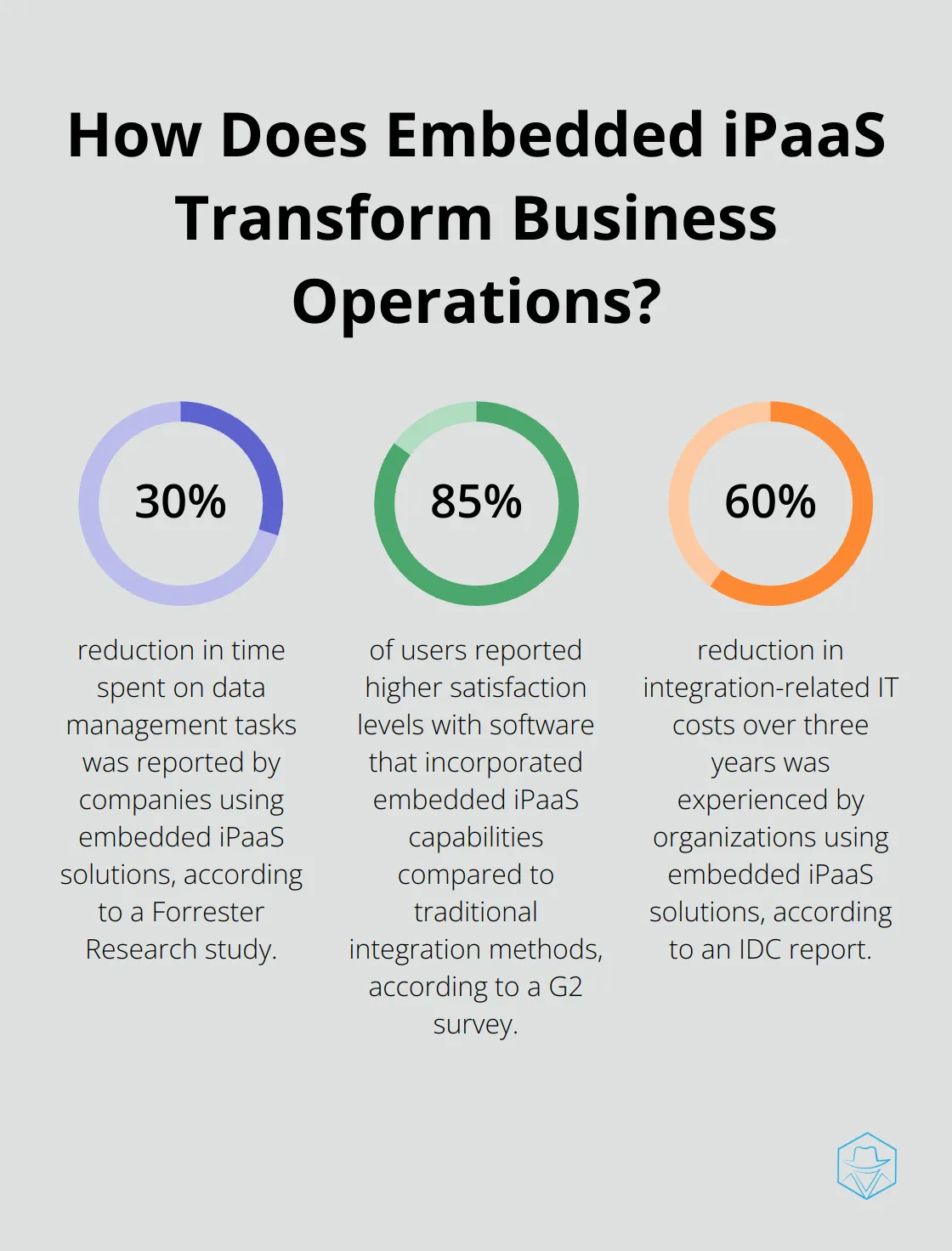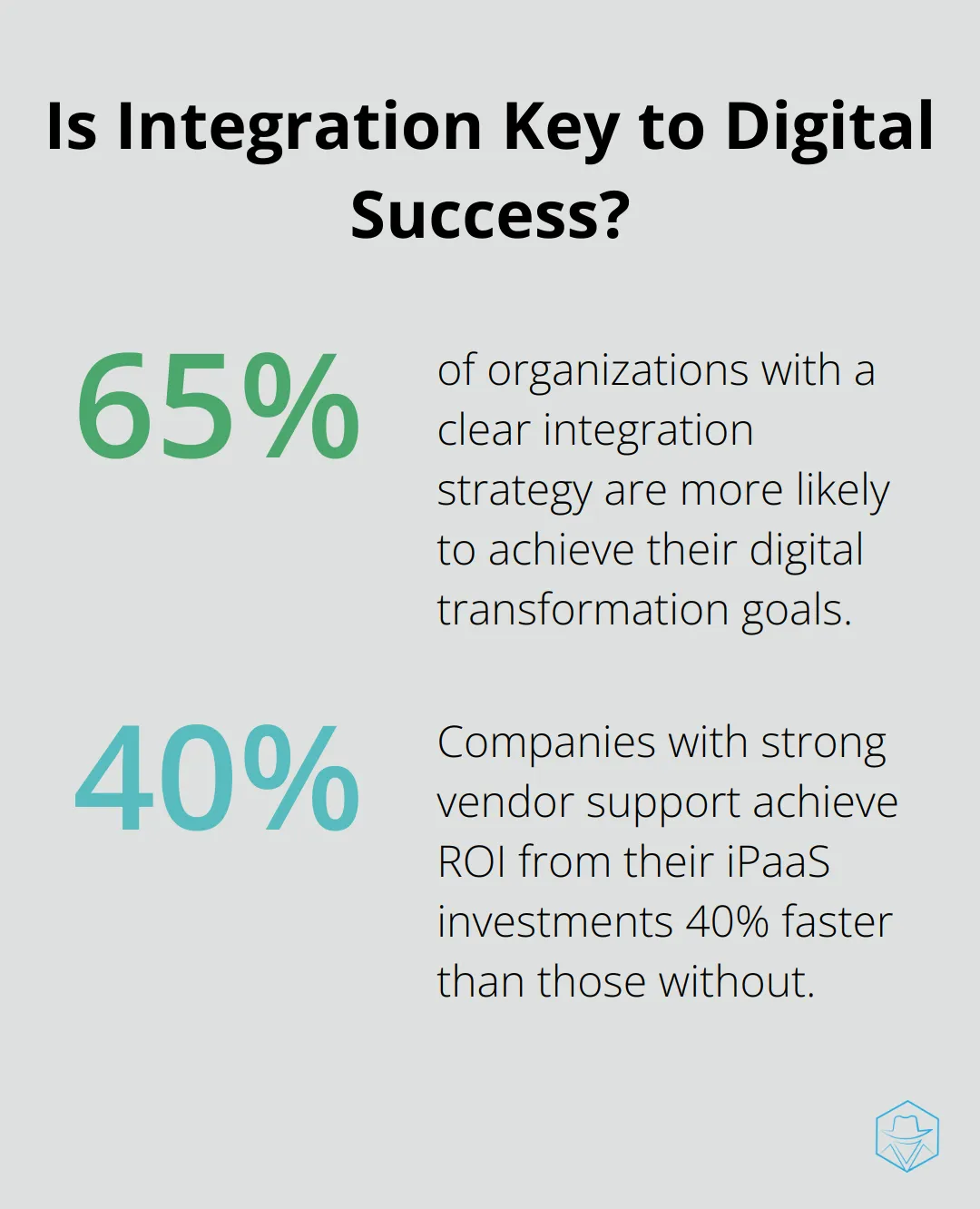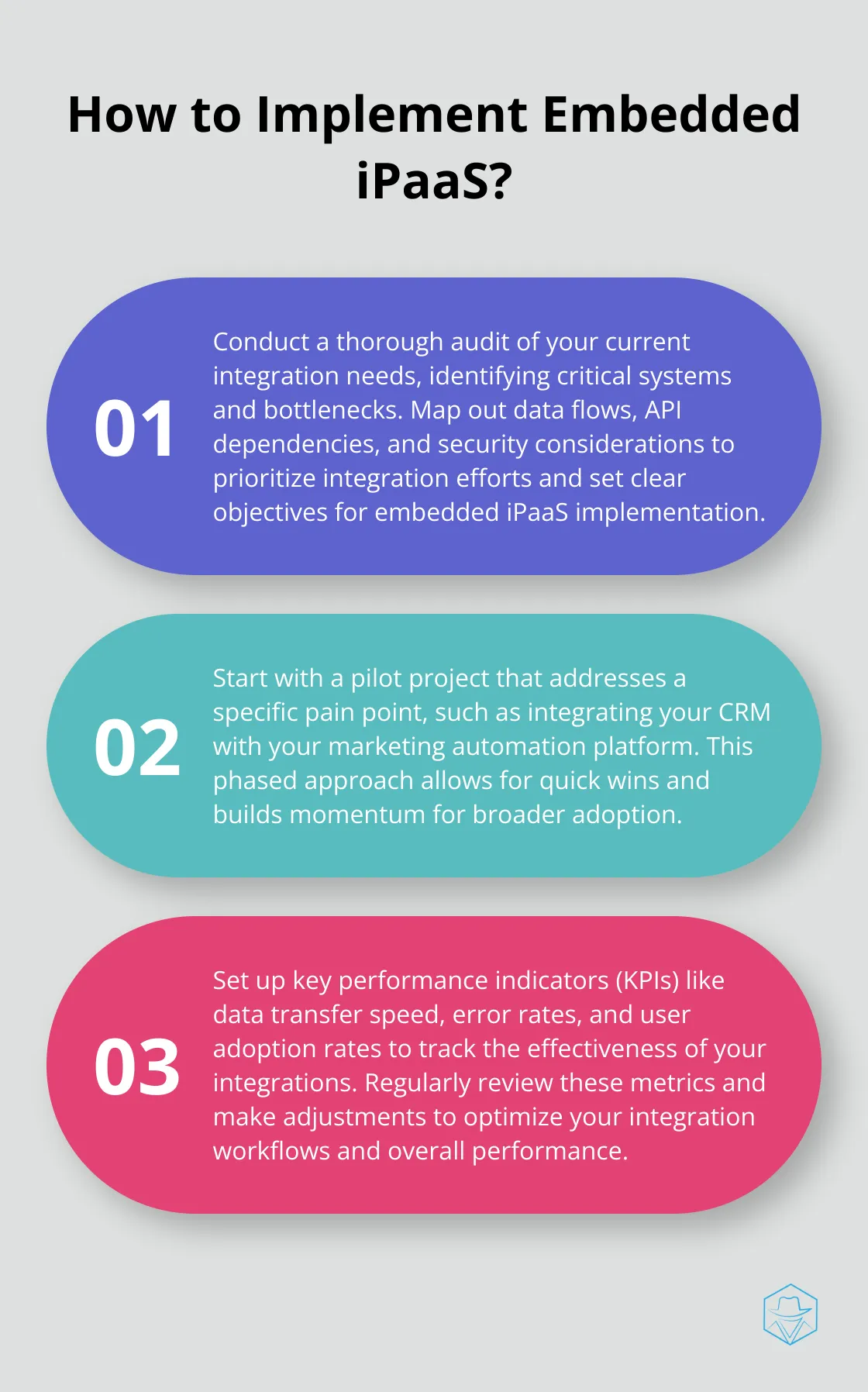Embedded iPaaS: Streamlining Integration Processes

At Drop Cowboy, we’re always looking for ways to streamline business processes. That’s why we’re excited to explore embedded iPaaS, a game-changing technology that’s revolutionizing how companies handle integrations.
Embedded iPaaS offers a powerful solution for businesses seeking to simplify their integration workflows and boost efficiency. In this post, we’ll dive into what embedded iPaaS is, its benefits, and how you can implement it effectively in your organization.
What Is Embedded iPaaS?
The Evolution of Integration Platforms
Embedded iPaaS (Integration Platform as a Service) transforms how businesses streamline their integration processes. This powerful tool allows software providers to incorporate integration capabilities directly into their applications, creating a seamless experience for users.

Traditional iPaaS solutions often require users to exit their primary application to manage integrations. This process can be cumbersome and time-consuming. Embedded iPaaS, however, keeps everything within the host application, which significantly improves user experience and workflow efficiency.
A recent study by Gartner projects the iPaaS market to reach $5.6 billion by 2024, with embedded solutions driving a substantial portion of this growth. This surge in adoption underscores the increasing demand for more integrated, user-friendly solutions in today’s fast-paced business environment.
Key Features of Embedded iPaaS
Embedded iPaaS solutions offer features designed to simplify integration processes. Pre-built connectors for popular SaaS applications stand out as a key feature, enabling rapid integration development. For instance, Workato (a leading iPaaS provider) offers over 1,000 pre-built connectors, which drastically reduces the time and effort required for integration.
Low-code/no-code visual editing tools represent another crucial feature. These tools empower non-technical team members to create and manage integrations without extensive coding knowledge. This democratization of integration capabilities can lead to significant time and cost savings for businesses.
Real-World Applications
The e-commerce sector has witnessed the transformative power of embedded iPaaS. Companies use it to automate order processing and inventory management across multiple platforms. This automation has resulted in a 40% reduction in manual data entry errors and a 25% increase in order processing speed.
In the financial services industry, embedded iPaaS enables real-time data synchronization between different systems. This synchronization improves risk assessment capabilities and allows for more personalized financial advice. A major bank reported a 30% increase in customer satisfaction after implementing an embedded iPaaS solution that provided a unified view of customer data across all touchpoints.
Strategic Advantage of Embedded iPaaS
Embedded iPaaS is not just a technological advancement; it’s a strategic tool that can give businesses a significant competitive edge. It enables faster, more efficient integrations, which allows companies to adapt quickly to changing market conditions and customer needs.
As we move forward, we’ll explore the specific benefits that embedded iPaaS brings to businesses, from improved workflow efficiency to enhanced user experiences.
Unlocking Business Potential with Embedded iPaaS
Supercharging Workflow Efficiency
Embedded iPaaS transforms business operations by dramatically improving workflow efficiency. This technology integrates directly into existing applications, eliminating the need for users to switch between multiple platforms to manage data and processes. The result? Substantial time savings. A Forrester Research study found that companies using embedded iPaaS solutions reported a 30% reduction in time spent on data management tasks.
Elevating User Experience
Embedded iPaaS significantly enhances user experience by providing a unified interface for all integration needs. Users can manage complex integrations without leaving their primary application, which reduces friction and increases productivity. A G2 survey revealed that 85% of users reported higher satisfaction levels with software that incorporated embedded iPaaS capabilities compared to traditional integration methods.
Accelerating Integration Deployment
In today’s fast-paced business environment, speed is king. Embedded iPaaS dramatically reduces the time required to develop and deploy new integrations. Instead of spending weeks or months on custom integration development, businesses can leverage pre-built connectors and low-code tools to create integrations in a matter of days (or even hours). This agility allows companies to respond quickly to market changes and customer demands, gaining a significant competitive advantage.
Driving Cost-Effectiveness and Scalability
Embedded iPaaS offers a cost-effective and scalable solution for businesses of all sizes. It reduces the need for custom coding and specialized IT resources, leading to significant savings on development and maintenance costs. An IDC report found that organizations using embedded iPaaS solutions experienced a 60% reduction in integration-related IT costs over three years.

Moreover, the scalability of embedded iPaaS allows businesses to easily add new integrations and handle increased data volumes as they grow. This eliminates the need for costly infrastructure upgrades and ensures that integration capabilities can keep pace with business expansion.
Enhancing Data Management and Analytics
Embedded iPaaS solutions excel at improving data management and real-time analytics capabilities. They enable businesses to consolidate data from various sources, providing a comprehensive view of operations. This consolidated view empowers decision-makers with accurate, up-to-date information, leading to more informed strategic choices.
For example, a retail company using embedded iPaaS to integrate its e-commerce platform, inventory management system, and customer relationship management (CRM) tool can gain real-time insights into sales trends, stock levels, and customer behavior. These insights can drive more effective inventory management, personalized marketing campaigns, and improved customer service.
As we explore the implementation of embedded iPaaS, it’s important to understand how to choose the right solution and overcome common challenges to maximize its benefits.
How to Implement Embedded iPaaS Successfully
Assess Your Integration Landscape
Start with a thorough audit of your current integration needs. Identify the systems and applications critical to your business operations and locate bottlenecks. This assessment will help you prioritize your integration efforts and set clear objectives for your embedded iPaaS implementation.

A recent survey by Gartner found that organizations with a clear integration strategy are 65% more likely to achieve their digital transformation goals. Take time to map out your integration requirements, including data flows, API dependencies, and security considerations.
Select the Right Embedded iPaaS Solution
The choice of the right embedded iPaaS solution is key for success. Look for platforms that offer a wide range of pre-built connectors, robust security features, and scalability to support your future growth. Consider factors such as ease of use, customization options, and the vendor’s track record in your industry.
When evaluating potential solutions, don’t just focus on features. Pay attention to the vendor’s support and training offerings. A study by Forrester Research shows that companies with strong vendor support achieve ROI from their iPaaS investments 40% faster than those without.
Plan for a Phased Implementation
Avoid the temptation to integrate everything at once. Instead, adopt a phased approach to implementation. Start with a pilot project that addresses a specific pain point in your organization. This allows you to demonstrate quick wins and build momentum for broader adoption.
For example, you might begin by integrating your CRM system with your marketing automation platform. Once you’ve successfully implemented this integration and measured its impact, you can expand to other areas of your business.
Overcome Common Implementation Challenges
Even with careful planning, you may encounter challenges during implementation. One common issue is resistance to change from employees accustomed to legacy systems. Address this by providing comprehensive training and highlighting the benefits of the new system.
Data quality issues can also pose problems during integration. Before implementation, clean and standardize your data to ensure smooth data flows between systems. Tools like data validation rules and automated data cleansing can help maintain data integrity.
Security concerns often arise when implementing new integration solutions. Ensure your chosen embedded iPaaS platform complies with industry standards and regulations. Implement strong access controls and encryption measures to protect sensitive data.
Monitor and Optimize
Successful implementation of embedded iPaaS requires continuous monitoring and optimization. Set up key performance indicators (KPIs) to track the effectiveness of your integrations. These might include metrics such as data transfer speed, error rates, and user adoption rates.
Try to regularly review these KPIs and make adjustments as needed. This might involve fine-tuning your integration workflows, adding new connectors, or providing additional training to users.
(It’s worth noting that some embedded iPaaS solutions, like Drop Cowboy, offer built-in analytics tools that can simplify this monitoring process.)
Final Thoughts
Embedded iPaaS has revolutionized how businesses handle integrations. This technology streamlines workflows, enhances user experiences, and accelerates time-to-market for new integrations. The cost-effectiveness and scalability of embedded iPaaS make it an attractive option for businesses of all sizes.

The integration landscape will continue to evolve with increased adoption of AI and machine learning in embedded iPaaS solutions. The rise of edge computing and IoT devices will drive demand for more distributed integration capabilities. Companies that leverage this technology will respond quickly to market changes, deliver superior customer experiences, and drive innovation across their organizations.
Drop Cowboy understands the importance of seamless integrations in modern business communications. Our platform offers features like Mimic AI™ for voice cloning and Smart Delivery™ for efficient global message delivery (all designed to enhance your marketing efforts through ringless voicemail and SMS). Businesses can create truly integrated communication strategies that drive engagement and results with embedded iPaaS technology.
blog-dropcowboy-com
Related posts

April 17, 2025
How to Find the Best Dropshipping Apps for Shopify
Discover the best dropshipping apps for Shopify. Boost your e-commerce store’s efficiency and profitability with top app recommendations!

April 9, 2025
Twilio Ringless Voicemail: What Is It and How Does It Work?
Explore Twilio ringless voicemail and learn its benefits and how it works for seamless communication without disturbing your recipients.

March 5, 2025
Best Ringless Voicemail Apps for Your Business
Explore top ringless voicemail apps to boost business communication and efficiency. Discover features, benefits, and how they can fit your needs.

March 9, 2025
Top Ringless Voicemail Drop Software Solutions
Explore top ringless voicemail drop software for efficient customer outreach and boost engagement in your communication strategy.

April 9, 2025
Landing Your Dream Marketing Automation Job
Land your dream marketing automation job with tips on skills, networking, and resume optimization to boost your career in the digital marketing field.

March 3, 2025
Comparing Top Ringless Voicemail Providers
Explore top ringless voicemail providers, compare features, pricing, and user reviews to find the best fit for your communication needs.